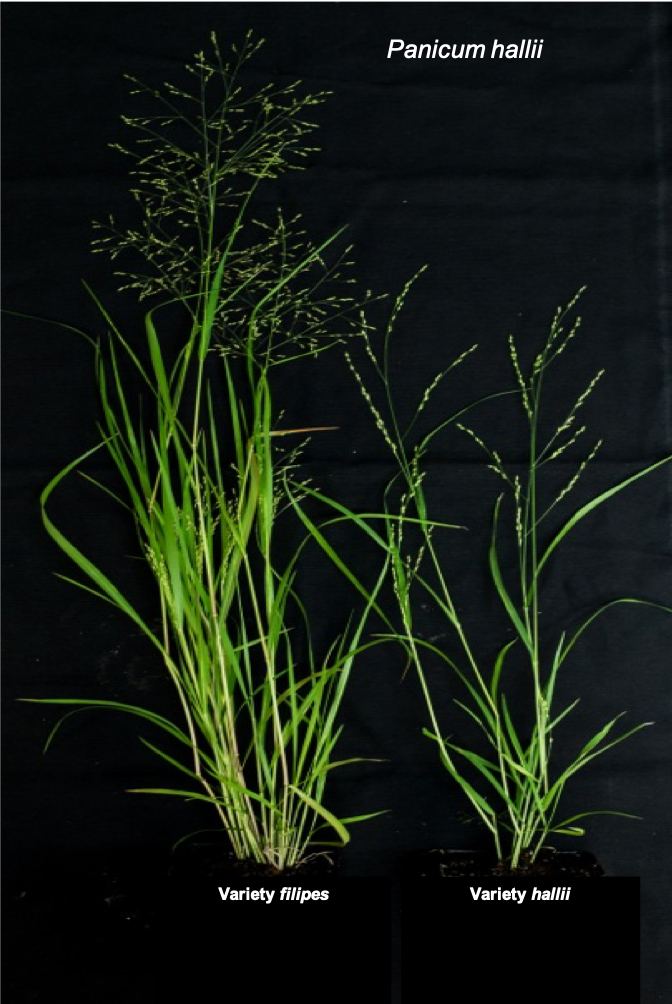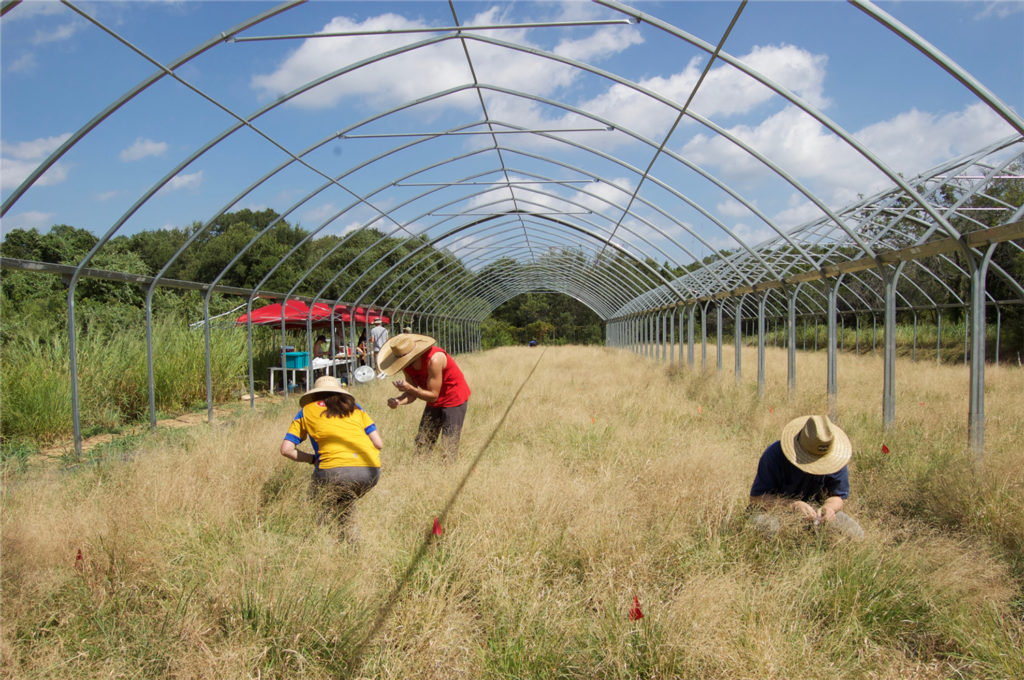Panicum hallii genomes offer insights to drought tolerance.
The Science

Representative morphology of Panicum hallii var. filipes and Panicum hallii var. hallii grown under controlled greenhouse conditions in Austin, Texas. Left is the FIL2 genotype; right is the HAL2 genotype. (Amalia Díaz)
Researchers have developed a genomic model to study drought tolerance in perennial grasses using Panicum hallii (Hall’s panicgrass), by generating two complete genomes from varieties that diverged over a million years ago. The hallii variety thrives in desert environments, while the filipes variety is less drought tolerant and is found in river and coastal environments.
The Impact
The perennial grass switchgrass (Panicum virgatum) is a candidate bioenergy feedstock with a complex genome with multiple copies of its chromosomes. Switchgrass has deep roots that allow it to access nutrients easily from a variety of soils and has a high tolerance of extreme water conditions such as drought and floods. The U.S. Department of Energy (DOE) supports research programs for developing methods for converting plant biomass into sustainable fuels for cars and jets. By studying a close relative model species like P. hallii, researchers can develop crop improvement techniques that could be applied to switchgrass.
Summary
Rising global temperatures are causing extreme weather events, ranging from prolonged droughts to extended periods of very heavy rainfall and severe flooding. With an ever-increasing global population, drought is an obstacle toward improving crop yields for food and fuel use.
In Nature Communications, a team led by Tom Juenger at the University of Texas (UT) at Austin and including researchers at the DOE Joint Genome Institute (JGI), a DOE Office of Science User Facility, report the culmination of nearly a decade of work to develop genomic resources for drought tolerance in perennial grasses. The team aims to apply the resources developed for P. hallii towards stress tolerance improvement in its more complex relative, the candidate bioenergy crop, switchgrass.

Field researchers studying drought responses in Panicum hallii at the UT Austin Brackenridge Field Lab. (David Gilbert)
Through the JGI’s Community Science Program, JGI sequenced and assembled near-complete genomes of P. hallii var. hallii (99.2% complete) and P. hallii var. filipes (94.8% complete) and resequenced a host of natural collections from across the species range. With these high-quality reference genomes for P. hallii, researchers can identify and characterize the regulatory elements that influence adaptation and tolerance to stressors such as drought. This information can be applied toward improving crop yields in other grasses.
The team conducted several large-scale field experiments and analysis to find relationships between sequence variation and plant stress responses. For example, offspring of a cross between the hallii (HAL2) and filipes (FIL2) varieties were subjected to a monthlong drought, and then half the plants were watered just before harvesting. As HAL2 has adapted to severe summer droughts, these plants were better able to uptake soil water compared to the other plants. The team used QTL mapping to find the genomic regions that control gene expression and physiological responses to drought. They found that trans-regulating factors are important regulatory elements that determine drought responses in P. hallii.
The HAL2 and FIL2 genomes are available on the JGI’s plant portal Phytozome.
Contacts:
BER Contact
Ramana Madupu, Ph.D.
Program Manager
Biological Systems Sciences Division
Office of Biological and Environmental Research
Office of Science
US Department of Energy
Ramana.Madupu@science.doe.gov
PI Contact
Tom Juenger
The University of Texas at Austin
tjuenger@austin.utexas.edu
Funding:
The work conducted by the US Department of Energy Joint Genome Institute, a DOE Office of Science User Facility, is supported by the Office of Science of the US Department of Energy under contract no. DE-AC02-05CH11231. The UT Brackenridge Field Lab and the Ladybird Johnson Wildflower Center provided support and field sites for experiments. This work was funded by NSF/IOS-1402393 (JTL), NSF/IOS-1639872 (JTL/TEJ), NSF/IOS-0922457 (TEJ), NSF/IOS-1444533 (TEJ), DOE/DE-SC0008451 (TEJ), DOE/DE-SC0018409 (DBL), DOE/DE-FC02-07ER64494 (DBL), and USDA/NIFA 2011-67012-309969 (DBL). Support was also provided by the Russian Government Program of Competitive Growth of Kazan Federal University.
Publication:
- Lovell JT et al. The genomic landscape of molecular responses to natural drought stress in Panicum hallii. Nature Communications. 2018 December 6. doi:10.1038/s41467-018-07669-x
Related Links:
- JGI Community Science Program
- JGI Science Highlight: Mapping water management traits related to panic grass variants
- CSP 2013 proposal: Developing Panicum hallii as a genetic and genomic model
- HAL2 genome on Phytozome: Panicum hallii var. hallii
- FIL2 genome on Phytozome: Panicum hallii var. filipes